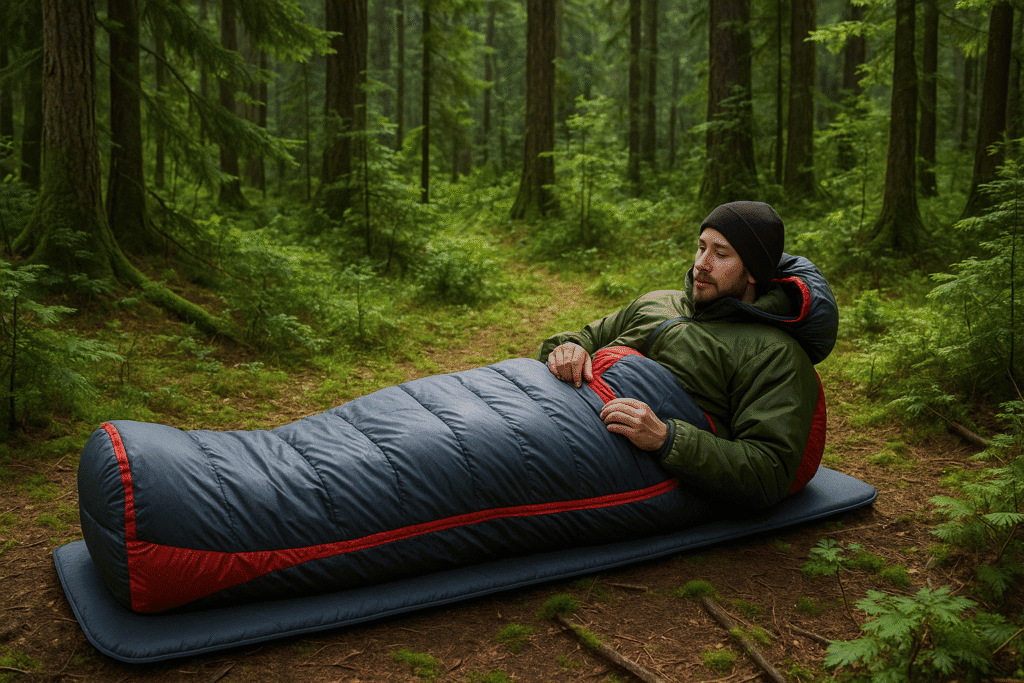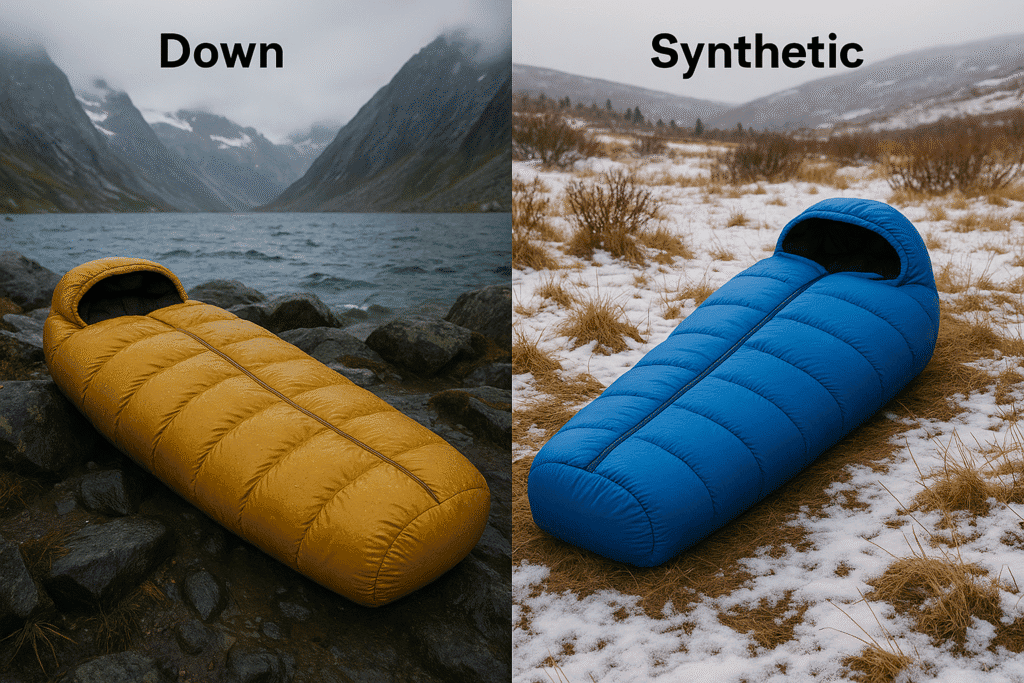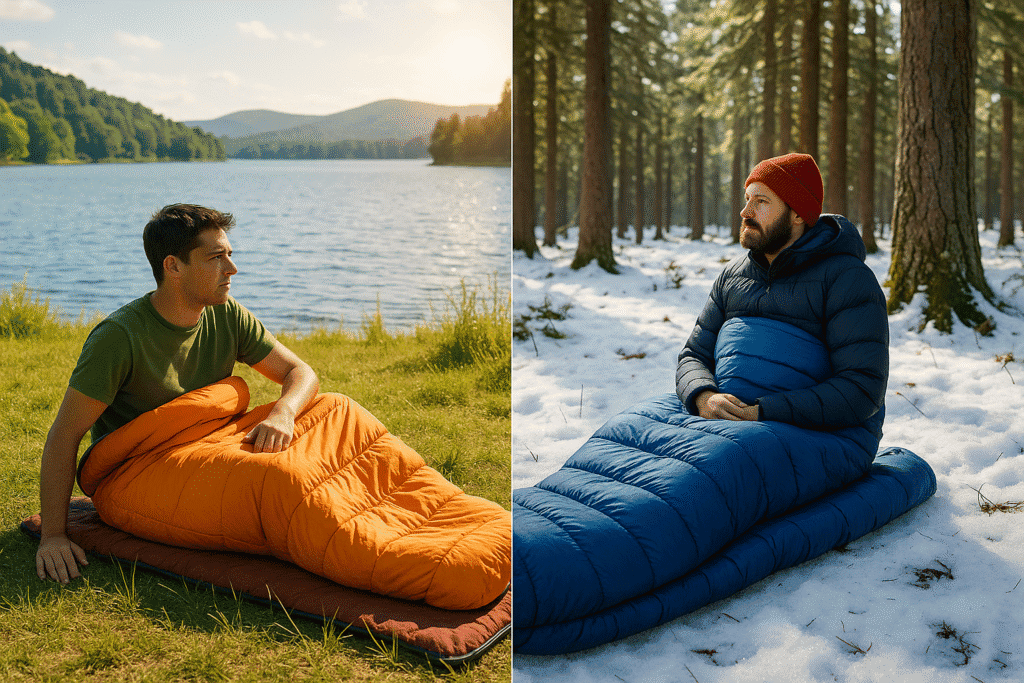Введение
Вы когда-нибудь просыпались от дрожи в своем спальном мешке, несмотря на то, что проверили температурный режим? Вы не одиноки. Правда о трехсезонных спальных мешках заключается в том, что их реальные характеристики в гораздо большей степени зависят от типа утеплителя и погодных условий, чем от того, что написано на этикетке.
На сайте Kelyland OutdoorsМы протестировали сотни спальных мешков в разных климатических условиях Китая - от влажных южных лесов до хрустящей северной осени. Главный урок? У каждого из пуховых и синтетических наполнителей есть подходящий сезон, когда они превосходят друг друга. В этом руководстве мы разберемся, какой утеплитель действительно подходит для весенних ливней, летних ночей и непредсказуемой осенней прохлады.
Понимание основ трехсезонных спальных мешков
"Трехсезонный спальный мешок предназначен для весенних, летних и осенних походов, обеспечивая универсальность и комфорт при температуре от 30 до 50°F".
Когда дело доходит до туристическое снаряжениеТрехсезонный спальный мешок - необходимая вещь для любителей активного отдыха. Эти мешки рассчитаны на разные условия весны, лета и осени, что делает их идеальными для большинства походов вне зимы. Идете ли вы с рюкзаком в горы или разбиваете лагерь у озера, понимание особенностей трехсезонного спального мешка поможет вам чувствовать себя комфортно и подготовленно.
Что определяет трехсезонный спальный мешок?
Трехсезонный спальный мешок предназначен для использования при умеренных температурах, как правило, в диапазоне от 30 до 50°F. В отличие от зимних спальных мешков, которые сильно утеплены для экстремального холода, в этих мешках соблюден баланс между теплом и воздухопроницаемостью. Часто они оснащены регулируемыми вентиляционными отверстиями, например, воротниками или молниями, которые помогают регулировать температуру в зависимости от условий.
Покрой весна/лето/осень с пояснениями
Одно из главных достоинств трехсезонного спального мешка - его адаптивность. Весной и осенью, когда ночи могут быть прохладными, утеплитель согреет вас. Летом более легкие материалы и возможности вентиляции предотвращают перегрев. Такая универсальность делает его практичным выбором для туристов, которые исследуют различные климатические условия.
Пух и синтетические утеплители
В трехсезонных спальных мешках используются два основных типа утеплителя: пух и синтепон. Пуховые спальные мешки Они легкие, хорошо сжимаются и обеспечивают отличное соотношение тепла и веса. Однако они теряют теплоизоляцию при намокании. Синтетические мешки, с другой стороны, сохраняют тепло даже во влажном состоянии и зачастую более доступны по цене. Компания Kelyland Outdoors специализируется на обоих видах мешков и предлагает индивидуальные варианты, соответствующие вашим потребностям.
Температурные показатели в реальных условиях эксплуатации
Производители указывают температурные показатели, чтобы сориентировать покупателей, но реальные условия могут быть разными. Мешок, рассчитанный на 30°F, может чувствовать себя комфортно при 35°F с соответствующими слоями. При выборе мешка всегда учитывайте такие факторы, как влажность, ветер и ваши личные привычки во время сна. Для рюкзаков часто предпочитают легкие пуховые трехсезонные спальные мешки из-за их компактности.
Почему универсальность имеет значение
Туристы сталкиваются с непредсказуемой погодой, особенно в переходные сезоны. Универсальный спальный мешок адаптируется к этим изменениям, снижая необходимость использования нескольких мешков. Обратите внимание на такие особенности, как регулируемые капюшоны, молнии и влагостойкие материалы, которые повышают эффективность работы в разные сезоны.
Сравнение характеристик трехсезонных спальных мешков
| Характеристика | Пуховая изоляция | Синтетическая изоляция | Идеальный вариант использования | Советы по уходу |
|---|---|---|---|---|
| Соотношение теплоты и веса | Высокий | Умеренный | Походы, сухой климат | Хранить в несжатом виде; не допускать попадания влаги |
| Характеристики при намокании | Бедный | Хорошо | Влажные или дождливые условия | Можно стирать в машинке; быстро сохнет |
| Упаковываемость | Превосходно | Ярмарка | Ультралегкий рюкзак | Используйте компрессионный мешок |
| Долговечность | Долговечность при уходе | Устойчивость к износу | Частое использование | Следуйте рекомендациям производителя |
| Стоимость | Выше | Более доступный | Бюджетные покупатели | Инвестируйте в зависимости от потребностей |
Выбор правильного трехсезонного спального мешка зависит от вашего стиля отдыха, бюджета и условий, в которых вы ожидаете оказаться. Независимо от того, предпочитаете ли вы легкую роскошь пуха или надежную работу синтетики, Kelyland Outdoors предлагает варианты, соответствующие вашим потребностям. Их опыт в производстве гарантирует качество и индивидуальный подход, помогая вам оставаться в комфорте в любое время года.

Пух против синтетики: Сравнение характеристик
"Выбирая между пуховым и синтетическим утеплителем для своего трехсезонного спального мешка, обратите внимание на соотношение тепла и веса, влагостойкость и компактность, чтобы соответствовать вашим походным потребностям".
Спор между пуховым и синтетическим утеплителем в трехсезонных спальных мешках - одно из самых важных решений, с которым сталкиваются туристы. Оба материала обладают неоспоримыми преимуществами, которые делают их подходящими для разных условий. Понимание этих различий поможет вам выбрать правильный спальный мешок для ваших приключений.
Соотношение теплоты и веса: Почему пух лидирует в сухих условиях
Пуховый утеплитель, обычно изготавливаемый из гусиных или утиных перьев, обеспечивает превосходное тепло при своем весе. Высококачественный пуховый спальный мешок может обеспечить исключительную теплоизоляцию, оставаясь при этом легким - идеальный вариант для тех, кто считает каждую унцию. Пух создает крошечные воздушные карманы, которые эффективно удерживают тепло, что делает его идеальным для холодных, сухих условий, где экономия веса имеет наибольшее значение.
Устойчивость к влаге: Преимущество синтетики
Синтетический утеплитель сохраняет свои согревающие свойства даже при намокании, что очень важно для влажной или дождливой среды. В то время как пух почти полностью теряет теплоизоляционные свойства при намокании, синтетические волокна продолжают сохранять тепло. Это делает синтетические трехсезонные спальные мешки лучшим выбором для походов в потенциально влажных условиях или прибрежных районах с высокой влажностью.
Сравнение упаковки
Пуховые спальные мешки сжимаются значительно меньше, чем их синтетические собратья, что позволяет существенно сэкономить место в рюкзаке. Однако синтетические мешки зачастую лучше восстанавливают свою форму после сжатия и не требуют столь бережного хранения. Испытания Kelyland в различных климатических условиях Китая показали, что, хотя пуховые мешки изначально меньше, синтетические сохраняют свои характеристики при многократном упаковывании и распаковывании.
Прочность и долговечность
При правильном уходе пуховые спальные мешки могут служить десятилетиями, в то время как в синтетических мешках утеплитель обычно разрушается после нескольких лет регулярного использования. Пух требует более тщательного ухода - его нужно хранить в несжатом виде и держать сухим. Синтетические мешки более просты и легко чистятся, что делает их более подходящими для случайных туристов или тех, кто предпочитает не требовать особого ухода.
Сравнение характеристик изоляции
| Характеристика | Пуховая изоляция | Синтетическая изоляция | Метод тестирования | Лучшее для |
|---|---|---|---|---|
| Теплота на унцию | Превосходно (мощность заполнения 800+) | Хорошо (зависит от типа волокна) | Контролируемая климатическая камера | Ультралегкий рюкзак |
| Влажное исполнение | Плохо (теряет изоляцию 90%) | Хорошо (сохраняет тепло 80%) | Имитация дождя | Влажные/дождливые условия |
| Сжимаемость | Превосходный (очень маленькие пакеты) | Умеренный (более объемный) | Стандартное испытание на сжатие | Упаковка с учетом пространства |
| Долговечность | Долговечность при уходе | Обычный срок службы 5-7 лет | Испытания на ускоренный износ | Долгосрочные инвестиции |
| Техническое обслуживание | Требует бережного хранения | Машинная стирка | Отслеживание использования в реальных условиях | Пользователи, не требующие особого ухода |
Выбирая между пуховым и синтетическим утеплителем для своего трехсезонного спального мешка, подумайте, где и как вы будете чаще всего ходить в походы. Строгие протоколы испытаний Kelyland в различных климатических условиях Китая - от влажного юга до сухого северо-запада - гарантируют, что их спальные мешки соответствуют реальным ожиданиям. Независимо от того, что для вас является приоритетом - экономия веса или устойчивость к погодным условиям, - понимание этих ключевых различий позволит вам сделать правильный выбор для ваших приключений на природе.

Руководство по сезонной адаптации
"Выбор правильного утеплителя для вашего трехсезонного спального мешка зависит от сезонных условий: синтетика лучше всего подходит для влажной погоды, а пух - для сухой и прохладной".
Выбор подходящего трехсезонного спального мешка требует понимания того, как различные утеплители работают в условиях весны, лета и осени. Каждый сезон ставит перед нами уникальные задачи, которые можно решить с помощью пухового или синтетического утеплителя. Конвертируемые варианты Kelyland предлагают гибкие решения для туристов, сталкивающихся с переменчивой погодой.
Весенний поход: Устойчивость синтетики к погодным условиям
Непредсказуемая весенняя погода делает синтетический утеплитель идеальным. Когда внезапный ливень или утренняя роса угрожают намочить ваше снаряжение, синтетические материалы сохраняют тепло лучше, чем пух. Влагостойкие свойства обеспечивают комфорт, несмотря на меняющиеся условия, что делает их идеальными для ранних сезонных приключений.
Летние ночи: Компактный пуховый комфорт
В теплые летние ночи, когда место в рюкзаке дорого, пуховые спальные мешки просто незаменимы. Их превосходная сжимаемость позволяет сэкономить место в рюкзаке, обеспечивая при этом достаточно тепла для прохладных горных вечеров. Легкость высококачественного пуха делает его отличным вариантом для летних походов с рюкзаком, где каждая унция имеет значение.
Осенние приключения: Синтетический край сырой погоды
При понижении температуры и повышении влажности осенью синтетический утеплитель сохраняет свои преимущества. Утренний мороз и сырость не повлияют на характеристики вашего спального мешка. Для осенних походов в потенциально влажных условиях синтетические трехсезонные спальные мешки обеспечивают надежное тепло независимо от влажности.
Решения для переходного периода
Для путешествий с переходом от одного сезона к другому идеальный баланс обеспечивают варианты Kelyland со смешанным наполнителем. Эти инновационные модели сочетают пух в сухих местах с синтетическим утеплителем там, где может скапливаться влага. Этот гибридный подход обеспечивает преимущества обоих материалов, легко адаптируясь к меняющимся условиям на протяжении всего путешествия.
Руководство по сезонной эффективности изоляции
| Сезон | Рекомендуемая изоляция | Ключевое преимущество | Диапазон температур | Kelyland Solution |
|---|---|---|---|---|
| Весна | Синтетика | Устойчивость к влаге | 40-60°F | Серия WeatherShield |
| Лето | Пух | Легкая упаковка | 50-70°F | Коллекция CloudLite |
| Осень | Синтетика | Работа в условиях влажной погоды | 30-50°F | Линия осенней тропы |
| Переходный период | Смешанное наполнение | Адаптируемая производительность | Переменная | Система AdaptaCore |
| Переменная | Кабриолет | Модульная гибкость | Настраиваемый | Опции SeasonFlex |
Понимание этих сезонных различий поможет вам выбрать правильный спальный мешок для ваших приключений. Опыт Kelyland в производстве как традиционных, так и инновационных гибридных спальных мешков гарантирует, что вы найдете идеальное решение для любой сезонной задачи. Их тщательное тестирование в различных климатических условиях Китая гарантирует реальную производительность, когда она вам больше всего нужна.

Система принятия решений покупателем
"Выбирая между пуховыми и синтетическими трехсезонными спальными мешками, необходимо оценить продолжительность путешествия, привычки сна, потребность в пространстве и бюджет".
Выбор идеального трехсезонного спального мешка - это не просто сравнение температурных показателей. Умные покупатели учитывают множество факторов, чтобы найти идеальный баланс между производительностью и практичностью. Опыт Kelyland помогает как индивидуальным туристам, так и розничным продавцам принимать взвешенные решения относительно своего ассортимента спальных мешков.
Продолжительность поездки
Для поездок выходного дня синтетические мешки предлагают отличную цену и более простой уход. Многодневные экспедиции часто выигрывают от превосходного соотношения тепла и веса пуха и его компактности. При выборе трехсезонного спального мешка учитывайте, сколько ночей вы будете проводить на открытом воздухе - любители частых походов обычно предпочитают пуховые мешки с длительным сроком службы.
Личные привычки сна
Любителям холодных снов следует искать мешки, рассчитанные на температуру на 10°F ниже ожидаемой, а любители теплых снов могут выбрать более легкий утеплитель. Пух обеспечивает лучшую терморегуляцию для тех, кому жарко, в то время как синтепон обеспечивает стабильное тепло и подходит для холодных спящих в сырых условиях.
Ограничения пространства упаковки
Любители ультралегких рюкзаков, которым важна экономия места, оценят сжимаемость пуха. Однако те, у кого рюкзаки побольше, предпочтут синтетику за ее устойчивость к погодным условиям. Услуги Kelyland в сфере B2B помогают розничным продавцам сформировать сбалансированные запасы для удовлетворения этих разнообразных потребностей туристов.
Бюджетные факторы
Хотя пух имеет более высокую первоначальную стоимость, его долговечность часто делает его более экономичным в долгосрочной перспективе. Синтетические мешки - отличный вариант для тех, кто отдыхает в походе время от времени. При выборе сумки учитывайте частоту походов и бюджет.
Матрица принятия решений по спальным мешкам
| Фактор | Преимущество при спуске | Синтетическое преимущество | Ключевое соображение | Kelyland Solution |
|---|---|---|---|---|
| Длина поездки | Многодневные поездки | Кемпинг выходного дня | Частота использования | Экспедиция против линий выходного дня |
| Стиль сна | Регулирование температуры | Постоянное тепло | Личный комфорт | Технология ThermoAdapt |
| Размер упаковки | Ультралегкая упаковка | Устойчивость к погодным условиям | Пространство против условий | Компактная серия по сравнению с серией Shield |
| Бюджет | Долгосрочная стоимость | Доступный вход | Стоимость за использование | Уровни Value и Premium |
| Техническое обслуживание | При правильном уходе | Легкая очистка | Обязательства пользователя | Руководства по программам ухода |
Эта система принятия решений помогает туристам оценить свои конкретные потребности при выборе между пуховыми и синтетическими вариантами. Комплексные B2B-услуги Kelyland позволяют розничным продавцам предлагать правильное сочетание товаров для своих клиентов, от любителей ультралегкого снаряжения до семейных туристов. Учитывая эти факторы, вы сможете найти трехсезонный спальный мешок, который идеально соответствует вашему образу жизни на природе.

Стратегии ухода и оптимизации
"Правильный уход может продлить срок службы вашего трехсезонного спального мешка на несколько лет: пух требует бережного хранения, а синтетика выигрывает от легкой чистки".
Для обеспечения максимальной эффективности и долговечности вашего трехсезонного спального мешка необходимо понимать специфические требования к уходу за каждым типом утеплителя. Послепродажная поддержка и запасные части Kelyland обеспечат вам сохранность ваших инвестиций на протяжении бесчисленных приключений.
Правильные методы хранения
Пуховые спальные мешки всегда следует хранить в несжатом виде в дышащем хлопчатобумажном мешке, чтобы сохранить объем. Синтетические мешки более щадящие, но все равно выгодны при свободном хранении. В комплект Kelyland входят сумки для хранения со всеми своими спальными мешками, чтобы помочь покупателям защитить свои инвестиции.
Протоколы очистки
Синтетические сумки обычно можно стирать в машинке, в то время как пуховые требуют специальных моющих средств для пуха и тщательной сушки. Kelyland прилагает подробные инструкции по чистке к каждому изделию и предлагает услуги профессиональной чистки для своих пуховых моделей премиум-класса.
Полевой ремонт
Оба вида утеплителя могут подвергаться незначительным разрывам. В комплект спальных мешков Kelyland входят ремонтные наборы: клейкие заплатки для синтетических мешков и пухонепроницаемая лента для моделей с перьевым наполнителем. Сотрудники отдела обслуживания клиентов помогут вам с ремонтом.
Повышение производительности
Добавление подкладки может расширить температурный диапазон вашего мешка и сократить частоту чистки. Kelyland предлагает индивидуальные вкладыши, которые идеально сочетаются с дизайном спальных мешков и обеспечивают оптимальные характеристики.
Сравнительная таблица технического обслуживания
| Аспект ухода | Требования к спуску | Преимущества синтетики | Поддержка Келиленда | Частота |
|---|---|---|---|---|
| Хранение | Подвешенный/неподвешенный | Более гибкие варианты | В комплект входит мешок для хранения | Непрерывный |
| Очистка | Специализированный процесс | Машинная стирка | Подробные руководства | Сезонная |
| Ремонт | Патчи, специфичные для даунов | Стандартный ремонт | Входящие в комплект ремонтные наборы | По мере необходимости |
| Обновить | Реставрация чердака | Умывание восстанавливает силы | Профессиональные услуги | Ежегодно |
| Аксессуары | Специализированные вкладыши | Универсальные опции | Нестандартные решения | Дополнительно |
Следуя этим рекомендациям по уходу, вы сможете гарантировать, что ваш трехсезонный спальный мешок будет работать наилучшим образом от поездки к поездке. Послепродажная поддержка Kelyland означает, что у вас всегда будет доступ к запасным частям, услугам по чистке и советам экспертов для поддержания вашего снаряжения в идеальном состоянии.
Заключение
Испытав спальные мешки в самых разных условиях - от влажных лесов до хрустящего горного воздуха, - я понял следующее: "лучшего" утеплителя не существует - главное, чтобы ваше снаряжение соответствовало вашим приключениям. Пух - хороший материал для сухих, легких путешествий, а синтетика согреет вас, когда погода станет промозглой.
В компании Kelyland мы видели, как туристы преуспевают и с тем, и с другим - главное, понять ваши потребности. Независимо от того, гонитесь ли вы за летними рассветами или осенним листопадом, ваш спальный мешок должен быть частью вашего набора инструментов, а не компромиссом.
Так что спросите себя: Где будет гореть ваш следующий костер? Ответ укажет вам на правильную сумку и ночи под звездами, проведенные правильно.
ЧАСТО ЗАДАВАЕМЫЕ ВОПРОСЫ
-
Q1: Что такое трехсезонный спальный мешок?
A1: Трехсезонный спальный мешок предназначен для использования в более холодных условиях весной, летом и осенью и способен выдержать температуру примерно до 20°F (-5°C). В этих мешках сбалансированы тепло, вес и объем, что делает их универсальными для различных походов.
-
Вопрос 2: Как выбрать трехсезонный спальный мешок?
A2: При выборе трехсезонного спального мешка учитывайте такие факторы, как температурный режим (обычно от 15 до 20°F), тип утеплителя (пух или синтепон), вес и размер. Обратите внимание на дополнительные функции, такие как воротники и молнии, которые повышают комфорт.
-
Q3: Можно ли использовать трехсезонный спальный мешок зимой?
A3: Хотя трехсезонный спальный мешок может справиться с холодами поздней осени и ранней весны, он может не обеспечить достаточной изоляции для экстремальных зимних условий. Выберите 4-сезонный Спальный мешок для температур ниже нуля.
-
Вопрос 4: В чем разница между пуховыми и синтетическими спальными мешками?
A4: Пуховые спальные мешки легче, легче сжимаются и обеспечивают исключительное тепло, но теряют теплоизоляцию при намокании. Синтетические спальные мешки более громоздкие, менее дорогие и сохраняют некоторую теплоизоляцию при намокании, что делает их подходящими для влажных условий.
-
Q5: Трехсезонные спальные мешки теплее двухсезонных моделей?
A5: Да, трехсезонные спальные мешки, как правило, теплее двухсезонных, они предназначены для защиты от более низких температур и часто имеют больше утеплителя, чтобы вам было комфортно в прохладные ночи.
-
Q6: Какой температурный диапазон охватывают трехсезонные спальные мешки?
A6: Трехсезонные спальные мешки обычно рассчитаны на использование при температуре от 20 до 32°F (от -6 до 0°C), что делает их идеальными для весенних, летних и ранних осенних походов.
-
Q7: Как упаковать трехсезонный спальный мешок в рюкзак?
A7: Чтобы упаковать трехсезонный спальный мешок в рюкзак, сожмите его в мешочек для экономии места и убедитесь, что он сухой перед укладкой. Поместите его в верхний или внешний карман рюкзака, чтобы легко достать после установки лагеря.
-
Q8: Какие характеристики следует искать в трехсезонном спальном мешке?
A8: Обратите внимание на наличие хорошо утепленного капюшона, воротника, водонепроницаемых материалов и молнии, позволяющей регулировать температуру. Кроме того, обратите внимание на вес и удобство сумки, если вы идете с рюкзаком.
Внешние ссылки
- Как определяются характеристики и температура спального мешка?
- Лучшие трехсезонные спальные мешки - Gear Institute
- Обзор кемпинговых спальных мешков - Trespass
- Лучшие трехсезонные спальные мешки для рюкзаков - Приключения в походе
- Лучшие трехсезонные спальные мешки на 2025 год - Outdoors Magic
- Лучшие трехсезонные спальные мешки на 2025 год - Trailspace
- Лучшие трехсезонные спальные мешки: для отличных приключений в походе
- Лучшие трехсезонные спальные мешки 2024 года - Hiking People

